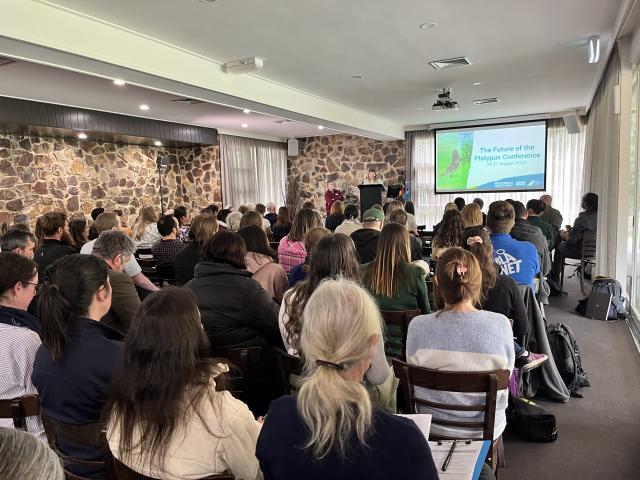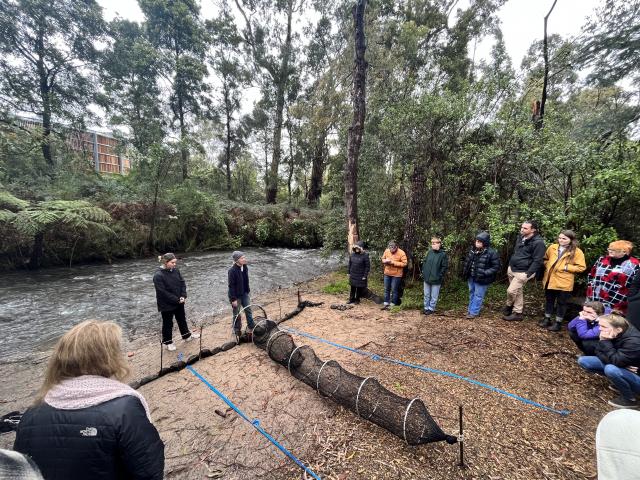By Tanya Steele
What lies on the horizon for the much-loved Australian platypus was chewed over by experts recently in a national conference held in Healesville from 29 to 31 August.
The ’Future of Platypus’ event was held at Healesville Sanctuary and brought together platypus researchers, vets and wildlife managers to share new knowledge on Australia’s favourite water-dwelling monotreme over three days.
Over 100 experts from across Australia and some from the USA and Denmark attended the event and Healesville Sanctuary Director Ross Williamson said it was the first national conference since 2019, and there was a lot to share, particularly after the devastating Black Summer fires and the enormous floods of the last two years.
“We were able to hear about the latest research into the biology and behaviour of the species, and the results of populations surveys which tell us what impact these landscape scale events are having,” he said.
Yarra Riverkeeper Charlotte Sterrett attended the conference and was impressed by the calibre of research and information presented – she is a part of the the Yarra Riverkeeper Association.
“If you went there, as a beginner, with an interest in platypus, you learnt everything from platypus biology, to why are they so unique – for example we learnt about mating periods and how they make their burrows,” she said.
The Yarra Riverkeeper association is about to commence it’s month long inaugural Birrarung Riverfest on 24 September – which will host a number of events designed to inspire people to be more connected to their local waterways and will include platypus monitoring.
“The are more active at dawn and dusk,“ Ms Sterrett said.
Rehabilitation and reintroduction is at the forefront for zoos across Australia and Ms Sterrett said there are a number of successful breeding programmes that are introducing platypus back into the wild.
Notably, platypus were returned to the wild in Royal National Park in NSW, after being locally extinct for 50 years.
“In between the 1940’s and 1990’s they were unable to breed any platypus in the wild,” Ms Sterrett said.
Humans have a large impact on the platypus and Ms Sterrett said they can be one of the biggest threats to the animals.
“Urbanization, we put in dams and weirs, we pollute the waters, we reduce the amount of water into rivers – one of the worst threats to them is not having water, reduced stream flow has a big impact and also not having enough trees and habitat,” she said.
“There were around 6,500 killed during the Black Summer bushfires, which is really terrible – while they’re in the water most of the time, they do nest and burrow on land.”
Mr Williamson said that the future of the platypus is by no means secure.
“Climate change is driving drought, bushfires and floods which are making life very difficult for platypus across many parts of its range,” he said.
The commissioner for environmental sustainability released a report on the Yarra River in 2018 and another is due to be released later this year.
“It listed them [the platypus] as good in the Upper Yarra, but ‘fair’ in the middle to lower catchments,” Ms Sterrett said.
The conference was the first major event for the new Australian Platypus Conservation Centre (APCC) which is located at Healesville Sanctuary.
“We need to get the experts together regularly to share information, so we have the best understanding of what’s happening to the species in the wild and know how we can best protect them – If we don’t then we run the risk of them disappearing without us knowing it is happening.” Mr Williamson said.
The APCC is a new initiative dedicated to furthering the understanding and conservation of this unique species.
Mr Williamson said that the success of the APCC will, however, depend on building partnerships with researchers, wildlife managers, citizen scientists and First Nations people.
“The APCC will provide a platform to bring partners together to work cooperatively. This platform will be facilities, knowledge, resources, and networks. Only through coordinated efforts will we be able to ensure that we do not lose this unique and iconic species from the wild,” he said.
Mr Williamson said that the APCC plans to work across three areas, conservation research, rescuing and rehabilitating injured and orphaned platypus, and increasing community awareness of the species.
“We hope that with the support of our members and visitors, we will be able to do more to ensure the future of our beloved platypus,” he said.
Overall the conference was a ‘tremendous’ success and Mr Williamson said the enthusiasm was tremendously heartening.
“We know that bringing these people together will make a difference to the future of the platypus,” he said.
Ms Sterrett enjoyed the conference but would also like to see how current research has been used to inform policy and practice.
“It was great for the first time back, but the conference was mainly focused on scientists and researchers presenting their research,” she said.
“It would be nice to discuss what the communities themselves are doing to engage in citizen science and how they are using some of the applied science that’s happening, then see how this knowledge is being shared in the broader community.”
Mr Williamson said that everyone went away with greater knowledge and new connections that will add a lot to their future work and that it was particularly heartening to see so many young researchers in the room and hear about the work they are doing.
“There was a lot of hope,” he said.








